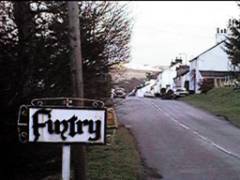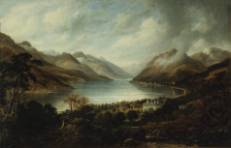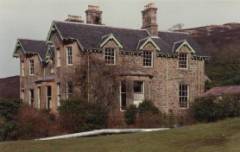
John MACGREGOR of Finnart, 1802-1858

John
Macgregor was christened on the 24th
August 1802 at Fintry, Stirlingshire. He was the third
son of James
Macgregor a clockmaker and Annie
McNicol. He also had one elder and two younger
sisters and two younger brothers. His father qualified as a clockmaker and he moved
through Balfron, Fintry and Comrie
with his family
working all the time as an engineer in the cotton mills that were developing in
these parts of the Highlands.


The
village of Fintry is situated in the valley of the Endrick, surrounded by hills.
Newtown of Fintry, is on the road about three-quarters of a mile to the west of
the village. A cotton mill was erected near there by Spears of Culcreuc in 1796
and the hamlet of Newton was built to accommodate the people employed in the
mill, who at one time amounted to 260 hands. The mill did not prove a success
and is now in ruin.
John
claimed that he was descended from Rob Roy MacGregor. In the John Macgregor WS
collection in the SRO at GD50/184/84 is a letter headed Melfort, Kilmelford,
Argyll. The text reads:
"Through my mother I am descended from Rob Roy.
My mother was a daughter (of) Donald McGregor great grandson of James
Mor the son of Rob who died in Paris….”
The
family were incomers to Fintry, having moved from Balfron. They remained there
for about 14 years, before moving on to Comrie in Perthshire, where the last two
of their eight children were born. The
stay in Comrie must have been short, although John received a rudimentary
education there. When John was 16, the whole family came to Glasgow.
John
began his apprenticeship as an engineer under David Napier at Camlachie.
Macgregor went to Lancefield Foundry with the others in 1821 and was a
sea-going engineer on the “Belfast” - which had Napier machinery - while
still in his early twenties. The “Belfast” plied between Liverpool and
Dublin, and was one of the earliest steamers to cross the Irish Channel.
At
David Napier’s he made the acquaintance of Mr David Tod. Together they ran the
engineering department for a while. They gained considerable managerial
experience during this period. They probably also acted as guarantee engineers
from time to time.
In
1833 he and his friend David Tod formed a
partnership to build steam engines
themselves. The partnership “Tod
and Macgregor” was initially based at Carrick Street, Glasgow in 1834. The business
grew quickly and moved to a larger property in Worroch Street, where they added
boiler making to their engineering activities.
Towards
the end of 1836 “Tod and Macgregor” opened a shipbuilding yard on the south
bank of the Clyde at Mavisbank. Finally in 1845 the firm moved to a new purpose
built yard at Meadowside in the Borough of Partick. “Tod and Macgregor” were
described as “the fathers of iron shipbuilding on the Clyde”, building
famous ships such as the “City of Glasgow” and the “City of Paris”.
In about 1830 he is assumed to have married Margaret
Fleming (born 23rd March 1809), the daughter of
James
Fleming and
Margaret
Biggar. Together they had seven children, of whom two boys and three girls
survived. They were:
· James Macgregor born 23rd December 1833, City Parish, Glasgow, Lanarkshire.
· Margaret Macgregor born 2nd October 1836, Barony, Lanarkshire.
· Anne Macgregor born 4th March 1840, Barony, Lanarkshire.
· John Macgregor born 13th April 1843, Barony, Lanarkshire.
· Janet Macgregor born about 1846, known as Jenny.
John had
fifteen grandchildren from the children of this marriage, although he
knew none of them, as he died before any grandchildren were born.
In 1834 John was to be found at 90 Carrick Street, but by 1841 had moved to Clydebank with Margaret and the family, who were found there at the time of the 1841 census. In 1845 he gave his address as Rutland Place; which may have been the same as Clydebank. The family must have moved as the shipyard went to Meadowside in 1846 as John was registered as living at Meadowside House, Partick in 1848.
On the 18th September 1848 Margaret Fleming died, the cause is not known, she was only 39.
On the 9th
of March 1851 John
married Margaret
York (born 20th
April 1823), the daughter of
William
York and Janet
Masterton, at Barony, Glasgow, Lanarkshire, Scotland.
At the time of the 1851 census, Margaret York, and the children from John's first marriage were found at Meadowside House in Partick. Finnart House on the banks of Loch Long is mentioned for the first time in 1854 (in 1853 it is not mentioned). Finnart House was a substantial house with servants’ quarters and a number of large reception rooms.
Built in approximately 1834 by John Anderson who still lived there in 1843. In the 186Os it was the home of Edward Craig, a relative of John and Edward Craig (born in Greenock), principal and professor respectively of Glasgow University. Between these dates it was the country house of John Macgregor.
He and Margaret
lived there and their son WY
Macgregor, later an artist and member of the group of artists known as the
“Glasgow Boys”, was born there.


Finnart in
the 19th Century
Finnart Now
Including
WY, he
had two further children with Margaret
York, they were:
·
William
York Macgregor born Finnart, Dunbartonshire, 14th October 1855;
died Oban, 28th September 1923
·
Peter
Macgregor born
21st February 1857 at Partick; Died Hove, Sussex 22nd April 1901
His life was cut short though, unfortunately what killed him might be a treatable problem today. He died on the 16th September 1858 after a very short illness. The previous week he had “put his elegant steam-yacht, the Finnart, at the service of the Commodore at the Blairmore regatta, and appeared in the highest spirits while dispensing its sumptuous hospitalities to the select party on board.” Daily Bulletin, Sept. 18th 1858.
When his funeral took place, at North Street, Anderston, the shops in Partick were closed, the route was lined with thousands of spectators with 'grieved countenances' the bells of the city churches were tolled from 2- to 3 o'clock’ and the flags in the harbour and on the shipping were at half-mast. Glasgow Citizen, Sept. 25th 1858
This is
the obituary from the Dumbarton Herald 23rd September 1858: “At the
comparatively early age of 57, in the full flush and vigour of his mature
manhood, after an illness of only three days, of constipation of the bowels, Mr
Macgregor departed this life, at half past eleven o'clock on Thursday night, at
his town residence, Meadowside House, Partick.”
It
is possible though, that the blockage was caused by cancer, which is still not
curable even now. His life might have been lengthened by modern medicine,
unfortunately cancer is still not curable today.
The whole of Partick is said to have stopped when his funeral took place, as a mark of respect. His memorial stone is to be found in the Glasgow Necropolis.
For
the execution of his will, his assets were valued at £130,517/12s. A very
considerable sum indeed. His share of Tod & Macgregor’s shipyard alone, which
was sold to David Tod on John’s death, was valued at £94,095/12/7.
Margaret
York lived on until 22nd April 1901 when she died at Bridge of
Allan, aged 78 years.
A rather sad note to end on:
North Street or Anderston Burial Ground as it was more commonly known, sadly
is no more, the burial ground fell foul of the City Planners and had to make way
for essential motorway developments. All the remains were exhumed and reburied
in the
Linn Cemetery in Castlemilk, Glasgow, in the early 1960's, but the memorials
were not transferred and may have sadly been reduced and consigned to mere
infill material during the course of the redevelopment.. No subsequent memorial
pays tribute to those somewhat ignobly disturbed from what should have been
there final place of rest. Fortunately a memorial stone to John Macgregor exists
in the Glasgow Necropolis.